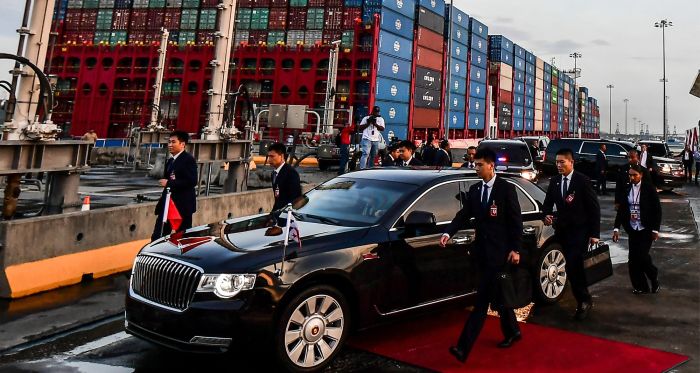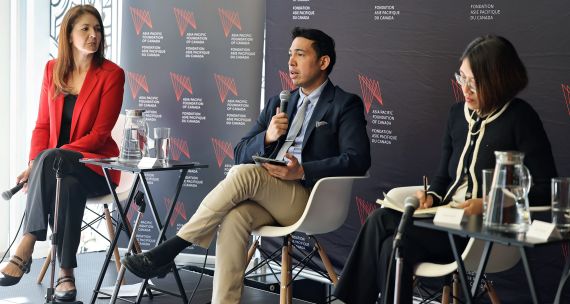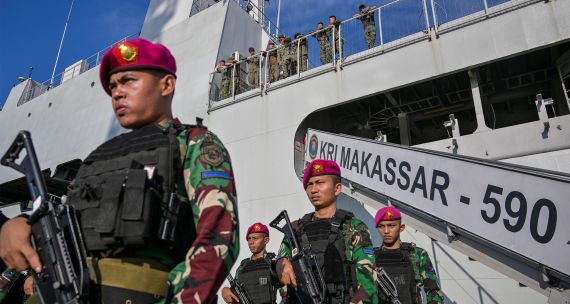Over the past two decades, China has gained a foothold in ports across the world, expanding its control and influence over critical shipping routes and vital resource hubs. China’s power and influence extend not just to commercial matters; several of these ports could have dual-use functions — that is, both commercial and military — and have become a new point of contention in the U.S.-China rivalry, especially now that both sides are ramping up their weaponization of trade.
The recent tussle over control of ports along the Panama Canal, a major artery of global shipping, is a harbinger of how this competition could play out elsewhere.
As of 2024, China had invested in at least 129 ports spanning nearly every continent (except Antarctica). Fourteen of these ports have become inactive, however, due to environmental or financial concerns or deteriorating political relations with the host country.
While there is currently no capital from Beijing or the Chinese private sector invested in Canadian ports, security concerns linger. One such concern is centred around the possible security vulnerabilities of Chinese-made port infrastructure, which is widely used at some of Canada’s most critical maritime gateways, such as the Port of Vancouver.
When and How Did China Become a Global Port Power?
Today, over 95 per cent of China’s international trade moves by sea, making access to reliable maritime infrastructure a strategic imperative for Beijing. China’s efforts to expand its influence over global ports are driven not only by commercial ambition but also by a desire to secure critical supply chains and reduce its dependence on vulnerable maritime chokepoints such as the Strait of Malacca and the Suez Canal. Control of overseas ports helps ensure a stable flow of essential imports, from food and energy to critical minerals.
These priorities began to crystallize around 2001, when China joined the World Trade Organization. At the time, the country was grappling with growing resource scarcity and domestic overproduction. To address these issues, Beijing formalized its ‘Going Out’ strategy, encouraging both state-owned enterprises (SOEs) and private companies to invest abroad, particularly in developing countries rich in resources and market potential. However, underdeveloped port infrastructure in many of these countries posed significant barriers to trade. As a result, port development quickly became a key focus of China’s outbound investment.
In the early 2010s, Beijing doubled down on expanding its political and economic influence with the launch of the Belt and Road Initiative (BRI), a sweeping plan to build land and maritime infrastructure across Eurasia, Africa, and Latin America. Backed by substantial state support, Chinese firms rapidly scaled up the financing and construction of ports around the world. Between 2013 and 2017 alone, Chinese companies were involved in developing at least 52 overseas port projects.
Alongside China’s port expansion has been a complementary military project — one Beijing sees as essential to protecting its growing interests abroad. Beijing codified this shift in its 2015 military strategy, which articulated a role for the People’s Liberation Army (PLA) in safeguarding the country’s overseas interests, including energy resources, maritime transport routes, and investments. In 2017, Beijing rolled out a plan to expand its marine corps by 400 per cent, including the deployment of troops at Chinese-operated ports such as Port Djibouti in East Africa and Gwadar in Pakistan.
Where Is China Building Ports, and Why Does It Matter?
Africa is the leading destination for Chinese port investment, with Chinese firms now involved in 78 ports — around a third of the continent’s total. Much of that investment has poured into West Africa, where there are vast reserves of oil and critical minerals. Meanwhile, on the continent’s eastern shore, China’s first overseas military base, located in Djibouti, sits just miles from American and allied military installations.
Chinese port activity has also been prominent in Latin America. As Washington’s influence in the region ebbed, China’s presence grew, most notably with the completion of the Port of Chancay in 2024 in Peru, home to some of the world’s largest copper and zinc reserves. Now the third-largest port in Latin America and the Caribbean (after Santos, Brazil, and Manzanillo, along Mexico’s western coast), Chancay can reduce shipping times between China and South America by 20 days, while allowing South American exporters to bypass U.S. and Mexican ports when trading with Asia.
This expansion of port infrastructure is closely tied to China’s growing dominance of trade in the region; the country is now South America’s top trading partner, with its exports to the region growing exponentially over the past two decades — rising more than 22-fold, from US$12.7 billion in 2002 to US$303.7 billion in 2022. These exports are primarily higher-value manufactured goods, including cars, cell phones, and computers. Imports from South America, meanwhile, include many agricultural products. By securing access to critical minerals and food supplies, China hedges against dependence on U.S. technology and exports.
Why are the U.S. and its Allies Concerned?
To the U.S. and many of its allies, China’s sprawling network of ports is seen not merely as a commercial endeavour, but as a calculated play to extend its military reach and geopolitical leverage.
The primary fear is that China could weaponize its holdings to disrupt supply chains, block access to critical raw materials and other essential goods, and sow broader instability in the global market. These worries extend beyond China’s control over the docks to key China-built infrastructure components, such as port cranes and surveillance systems.
Another set of concerns is more explicitly military-related. As noted above, some Chinese-linked ports are located near U.S. military facilities, such as Djibouti’s Doraleh Multipurpose Port, in which China is a major investor. This port lies just 12 kilometres from Camp Lemonnier, the largest U.S. military installation in Africa. Similarly, in the United Arab Emirates, the Port of Khalifa, which is operated by a Chinese shipping conglomerate, is roughly 80 kilometres from a U.S. airbase in the Persian Gulf. Washington is wary that, in the event of a crisis, Beijing could use its leverage over these ports to monitor, interdict, or restrict U.S. military deployments.
These risks are compounded by the U.S. military’s reliance on commercial logistics. Around 90 per cent of its cargo transits via commercial vessels, potentially giving port operators visibility into the timing and scale of U.S. operations. A key concern pertains to equipment manufactured by Chinese firms. For instance, Zhenhua Heavy Industries Company Limited (ZPMC), a Chinese state-owned engineering company, supplies about 70 per cent of the world’s port cranes. These cranes could give Beijing backdoor access to sensitive shipment data, including details on U.S. military equipment. Even at ports not directly controlled by Chinese companies, the widespread installation of Chinese-made surveillance cameras and monitoring systems is another potential vector for espionage.
Finally, there is apprehension in the U.S. and among its allies that, China could exploit its global port access to pre-position weapons, ammunition, and other equipment under the guise of civilian use, should a military conflict break out. At least 14 Chinese-owned overseas ports are reportedly capable of supporting naval operations, raising the prospect that the PLA could use them to rearm and replenish far from home.
How is the U.S. Responding?
The U.S. has attempted to block Chinese port deals, especially in locations it considers strategically sensitive. For instance, in 2021, Washington pressured Croatia to cancel a deal with China to build and operate a modern container terminal at Rijeka, a deepwater port that provided direct access to Central European markets. The contract was subsequently awarded to a Danish company.
In May 2025, a U.S. firm (and one with which U.S. Deputy Secretary of Defense Steve Feinberg has reportedly had business linkages) was seeking to acquire the Port of Darwin, which is currently under a 99-year lease to a Chinese company. The port is a strategic asset on Australia’s northern coastline and close to both the U.S. and Australia’s military outposts. In 2024, it was revealed that the U.S. had invested hundreds of millions of dollars in building air force facilities in Darwin, part of a broader effort to counter China’s growing presence in the Indo-Pacific.
The U.S. Congress also introduced bipartisan legislation in February 2025, referred to as the Strategic Ports Reporting Act, which would task federal agencies with identifying foreign and domestic ports vital to U.S. military, diplomatic, economic, or resource interests, and tracking attempts by China to gain control over these ports.
The next major test of U.S. resolve on this matter, however, will likely be over the Panama Canal. The canal serves as a critical maritime nexus connecting the east coast of the U.S. to Asia and the west coast of the U.S. to Europe, and facilitates intercoastal trade within the U.S.
During normal operating times, it is the fastest route for trade between the U.S. East Coast and Asia. Over 74 per cent of the trade volume transiting the waterway either originates from or is bound for the U.S., making the U.S. the canal’s pre-eminent user. The route is particularly crucial to Washington’s strategy of using energy as diplomatic leverage in the Indo-Pacific, as it serves as the primary channel for U.S. energy exports, including crude oil, refined fuels, and liquefied natural gas, as well as Canadian crude oil that is re-exported via U.S. terminals and bound for Asian markets.
In security terms, the canal is a linchpin for U.S. naval deployments, enabling the swift transfer of vessels between the Atlantic and Pacific oceans. Loss of access to the canal could delay U.S. naval deployments to the Pacific by weeks.
In March, under U.S. pressure, a private Hong Kong company, CK Hutchison, announced it would sell its operational rights to 43 ports — including two in Panama — to a consortium led by the U.S. firm BlackRock. Beijing quickly pushed back, launching an antitrust probe in hopes of halting the deal.
After the exclusive negotiating window with BlackRock expired in July, CK Hutchison opened the door to China’s state-owned shipping giant Cosco, which is now seeking a 20 to 30 per cent stake in the future ownership of CK Hutchison’s port portfolio. Ultimately, the outcome may hinge on a decision by the Panamanian government; President José Raúl Mulino is now reportedly weighing whether to cancel the port contract with CK Hutchison, while local lawsuits have been filed seeking to nullify the firm’s hold on the ports.
Beijing has strong incentives to either stall the sale or secure a stake in it. Hutchison’s holdings span 23 countries and sit along major shipping lanes, including ports in The Bahamas and routes connecting the U.S. and Ukraine. Ceding these assets to Western hands would be more than a commercial setback and could rein in China’s great-power ambitions while stripping Beijing of valuable political proxies at a time of growing U.S.-China tensions.
What is China’s Involvement and Interest in Canada’s Ports?
Both Chinese SOEs and CK Hutchison have probed opportunities to expand into Canada’s port infrastructure, but so far have been unsuccessful. In 2015, the China Communications Construction Company proposed developing a container terminal in Sydney, Nova Scotia, but the project was quietly shelved after bilateral relations soured in 2018. A separate C$775-million terminal initiative involving CK Hutchison at the Port of Québec was scrapped by the federal government in 2021 on environmental grounds.
Canada’s resource-rich North is also on Beijing’s radar, as it looks to fill infrastructure gaps and gain access to critical mineral deposits. Nevertheless, mounting national security concerns have made Ottawa more cautious about Chinese investment. The government has increasingly relied on policy tools such as the Investment Canada Act to screen foreign SOE investments, making it more difficult for Chinese capital to gain a foothold. Notably, in 2020, Ottawa blocked the proposed takeover of a Nunavut gold mine by a Chinese SOE following a national security review under the Act.
Still, Canada’s ports are not beyond Beijing’s reach. The ports of Halifax, Prince Rupert, and Vancouver rely on cranes manufactured by ZPMC, a Chinese firm whose hardware has been flagged by U.S. authorities as a potential surveillance risk capable of paralyzing port operations. At the Port of Halifax alone, seven of nine ship-to-shore cranes are ZPMC-built. While Chinese equipment is often selected for its cost advantage, concerns over cybersecurity are becoming harder to dismiss. In 2023, Transport Canada said it knows of no cases where crane equipment at Canadian ports was used for tracking or disruption, but is gathering crane-specific data to update security assessments. However, details of any actions have not been made public.
• Edited by Vina Nadjibulla, Vice-President Research & Strategy, Erin Williams, Director, Programs, and Ted Fraser, Senior Editor, APF Canada.





